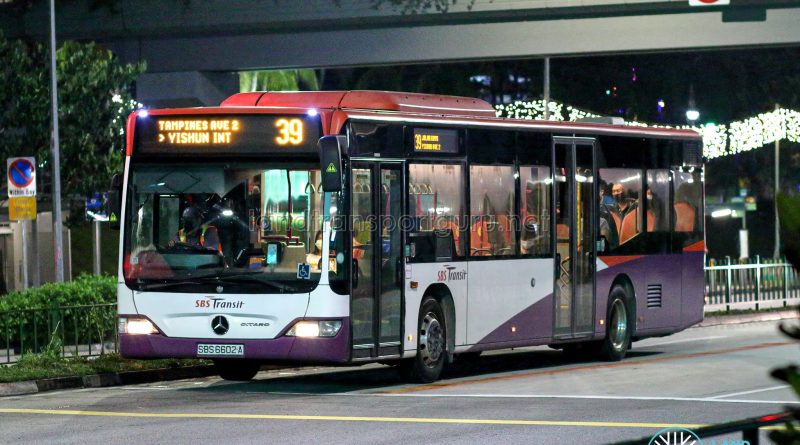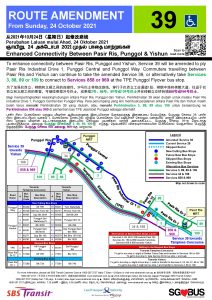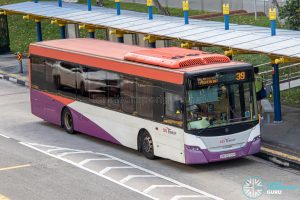Transport planning is an unenviable task of balancing the needs of commuters with the efficient use of resources. While unprofitable and underutilized bus routes have been curtained in the past, the recent move to amend Service 39 has struck discord with residents of Pasir Ris and Yishun, with members of the public calling for a stop to this arrangement.
Since 2009, the Land Transport Authority (LTA) had took on the role of being a centralised bus planning agency; a role which was further strengthened in 2016 with the advent of the Bus Contracting Model, allowing it to take control over service levels. LTA’s role as a centralised bus planning agency ‘allows it greater flexibility to respond to changes in bus service levels’.
The original planned amendment
As announced on 19 September 2021 on the Facebook page of Mr Teo Chee Hean, Member of Parliament (MP) for Pasir Ris-Punggol GRC, Bus Service 39 would be amended to serve Punggol New Town via the newly extended Pasir Ris Industrial Drive 1, skipping 2 pairs of bus stops along Pasir Ris Drive 12 and TPE.
Prior to the extension of Pasir Ris Industrial Drive 1 to link up with Punggol Central, residents of Pasir Ris and Punggol have long relied on the TPE to connect between the 2 estates. Since 19 October 2003, Service 3 has served as the main bus service connection between Pasir Ris and Punggol, but takes a slight detour via Pasir Ris Street 71 and Punggol Field before reaching their respective town centres.
With the opening of the extended Pasir Ris Industrial Drive 1 earlier this year, consultations have been conducted between the residents of Pasir Ris and Punggol with the MPs of Pasir Ris-Punggol GRC to introduce a bus service that provides a faster connection between the 2 estates via the extended road.
19 September 2021 – Public Reactions
These amendments were first announced in a Facebook post by Mr Teo Chee Hean on Sunday, 19 September 2021, slightly more than a month ahead of the bus service amendment. Public reactions to this bus route amendment were mixed, with more disapproving reactions than positive comments. Most discontent was directed to the extended travel duration between Pasir Ris and Yishun, after the service is amended to travel through Punggol.
Our take on Service 39
We present the following for and against the amendment of Service 39, along with potential outcomes.
Reasons for retaining existing route for Service 39
1. Complement loading on Bus Service 88/89/109/858/969
With many Pasir Ris residents relying on Services 88, 89 and 109 between Pasir Ris and TPE, as well as Services 858 and 969 between Yishun and TPE, Service 39 serves to distribute out the crowds on these trunk routes.
2. Duplicity of future Cross Island Line (CRL)
The proposed amended route for Service 39 will duplicate the Punggol Extension of the future Cross Island Line (CRL) between Pasir Ris and Punggol, which is scheduled for completion in 2031.
When the Punggol Extension opens in 2031, commuters who use the amended Service 39 will more likely prefer to take the new MRT line over the bus, which leads to an excess supply of public transport resources to provide connections that are better catered by the MRT.
3. Increased travel time and hassle
For Pasir Ris and Yishun residents, alternatives offered to Service 39 involve taking Services 89 or 109 to the TPE bus stops and transferring to Services 858 or 969 to get to Yishun, or Services 168 or 858 to Jln Kayu.
However, the need to transfer between multiple bus routes is an added inconvenience to Pasir Ris and Yishun residents. This also increases travel time to destinations to other areas in the Northern region of Singapore, specifically for the residents of Pasir Ris, who already lack other alternative travel options besides Service 39. Additionally, residents have pointed out that Services 858 and 969 are already overcrowded during the peak hours.
4. Car-lite nation
In recent years, the LTA has pursued the long-term strategy of cultivating a car-lite nation, in part by improving the speed and connectivity of public transport. In its Land Transport Master Plan (LTMP) 2040, it also envisions a ‘45-minute city’, where most commuters would spend no more than 45 minutes to complete journeys between their home and workplace.
It would seem like the move by LTA to lengthen long-distance expressway bus routes contradicts its long-term strategy for promoting a car-lite society. The move to lengthen the route of Service 39 reduces the attractiveness of the bus service for Pasir Ris and Yishun residents travelling between the 2 estates. Moreover, the proposed amendment only benefits a smaller minority of commuters who prefer a faster bus service connection between Pasir Ris and Punggol.
Reasons for amending the route of Service 39
1. Availability of existing public transport connections
Pasir Ris already benefits from stronger public bus connections to the Northern region of Singapore since the opening of Tampines Expressway (Punggol Road) Bus Interchange in 2014. Services 3, 88, 89 and 109 offer direct connections between Pasir Ris and the bus stops along TPE, which can be utilised to connect to other bus services heading towards the Northern region of Singapore.
Yishun has even more public bus connections to the Eastern and Northeastern regions of Singapore since the late 1990s and early 2000s with the route extension of Service 858 (1997) and introduction of Services 969 (2001), 965 (2002) and 85 (2006). In addition, Service 117 was introduced in 2015 under the Bus Service Enhancement Programme (BSEP), providing additional links from Yishun to the Seletar Aerospace Park and Punggol New Town.
Currently, LTA’s approach to building up the public transport network revolves around the hub and spoke model, where the rail network forms the backbone of the public transport network, and feeder bus services connecting these transport nodes with residential estates. This concept allows more origin and destination pairs to be served, by transferring between different modes of public transport (bus or train) that can be maintained at high frequencies.
2. Duplicity of existing bus routes
Service 39 is fully duplicated by other bus routes along the skipped sectors post-amendment, such as:
- Services 88, 89, 109: between Pasir Ris Dr 12 and TPE
- Services 168, 858: between TPE and Jalan Kayu
- Service 858: between TPE and Yishun
- Service 969: between Tampines / TPE and Yishun
By using the other bus services plying the expressway to the Northern region of Singapore, destinations served by the skipped sectors of Service 39 can be reached from Pasir Ris and Yishun with 1 transfer.
3. Setting a precedent for future bus routes
The rationalization of bus services is never a popular move, particularly for Pasir Ris residents long accustomed to having convenient bus access to the Northern region of Singapore. However, public discontent this time is more significant than in previous occasions.
While the LTA has presented arguably valid reasons for amending Service 39, backtracking on the withdrawal in the face of public criticism might set off a precedent for commuters to resist future bus rationalization efforts. One cannot be certain if grassroots will leverage on inciting public opinion to strongarm LTA into abandoning any sort of amendment of rationalization of bus routes in the future.
One recent case of LTA backtracking on route amendments after they are announced to the public was in September 2020, when it intended to extend Service 101 to Buangkok MRT station. These plans were shelved following negative feedback, and a new Service 114 was later implemented in October 2020.
Counterarguments to reasons supporting withdrawal:
1. Services 858 & 969 as ineffective alternatives
Despite planning public transport around the hub and spoke model, there still leaves room for key point-to-point express services that can be justified by passenger demand. The overcrowding faced on Services 858 and 969 during peak hours despite the deployment of articulated and double-deck buses respectively shows that forcing commuters to transfer to these 2 services instead will lead to even more severe overcrowding, which may result in commuters having to wait for the next bus, leading to later arrivals at their schools or workplaces.
2. Other forms of wastage
While LTA is right to exercise prudence in the use of public funds, the agency also fell short in managing other costs involved in Bus Contracting. In recent years, it has over-procured buses in the desire to reinforce critical stretches of the rail network with buses in the event of rail disruption as highlighted in the Committee of Supply Debate 2018. However, with largely successful rail renewal efforts, these duplicating services have been largely withdrawn, and as of August 2020, LTA is keeping over a hundred registered buses in storage due to lack of use for these buses.
What can LTA do:
For the planned amendment of Service 39, there are several courses of action that LTA can take:
1. Do nothing
This is the most likely option. Based on past experiences, online sentiment will blow over, and the general public will acquiesce to its planning decisions. Affected commuters will adopt alternative travel routes after the amendment of Service 39.
2. Throw in the towel
As it had done previously in 2020, the LTA could choose to defer or cancel the proposed amendment of Service 39. This would buy it some time to re-evaluate alternatives, and placate negative public sentiment towards the withdrawal.
3. Introduce other bus services between Pasir Ris and the Northern region of Singapore
To continue offering direct Pasir Ris – Yishun connections, another northbound expressway bus route like Service 969 could be amended into Pasir Ris. However, the amendment of any service into Pasir Ris would inconvenience existing commuters with longer journey time.
As a compromise, a new service could be intoduced between Pasir Ris and the Northern regions of Singapore to provide an alternative link to reduce the impact brought about by the route amendment of Service 39.
Timeline:
- 2021 (19 Sep): Route amendment to Service 39 announced on Facebook page of Mr Teo Chee Hean. Many residents react negatively to the news.
- 2021 (24 Sep): Press release published by SBS Transit regarding the route amendment for Service 39.




Could have introduced 39e instead to ply 39’s old route
There’s only one problem with scenario 3. Once CRL opens, one of the services will be withdrawn and it will likely be 39
Comments post-amendment of sv 39:
Let’s say someone is travelling from Pasir Ris West Plaza to Khatib MRT.
Estimated time taken (excluding waiting time):
3/89/109 > 858/969: 27-30 mins (Taking sv858 has a difference of around 3 more minutes as compared to taking sv969)
Or sv39 direct: 37 mins (13 minutes to Opposite Waterway Point, 24 minutes from Opposite Waterway Point to Khatib MRT)
With the estimated travelling times above, I conclude that most of the people taking pre-amended sv39 would continue to take the amended sv39 for a few reasons:
1. Irregular frequency of buses to TPE stop from Pasir Ris, except for sv88 which goes via Drive 3.
2. Possibility of not getting a place on 858/969 at TPE stop due to crowds from Tampines/Airport, and 858 frequency not consistent at times.
And 3. Guarantee of getting a seat for those boarding at Yishun Int, especially with more double-decks now compared to pre-amended sv39, and sv 858/969 might already be packed from Chong Pang/Sembawang upon reaching Northpoint bus stop.
Therefore since there is not much difference between taking sv39 vs transferring at TPE bus stop when factoring in waiting times, Pasir Ris-Yishun commuters would still most likely continue to take sv39.
Having said that, commuters going especially from Punggol West to Yishun might not be able to board sv39 if a single-decker bus comes, and might need take the next sv39, or just take 117 since difference is just around 15 minutes, and 117 covers much more of Yishun.
For those going from Pasir Ris to areas like Chong Pang/Gambas, transferring at the TPE bus stop might still be a better option.
Hope this analysis is helpful for those affected by the amendment of sv39.
It’s official guys! LTA didn’t cancel the amendment, therefore Service 39 amendment happened today!